Finance Minister Enoch Godongwana’s Medium-Term Budget Policy Statement (MTBPS) has laid out the government’s financial plan for the next few years, and for South Africans feeling the pinch, the message is one of cautious stability over immediate relief. The “mini-budget” reveals a treasury walking a tightrope between maintaining fiscal discipline and addressing a struggling economy.
Here’s what the statement means for you and the country’s financial health.
The Big Push: A Lower Inflation Target
In a move with long-term implications, the minister endorsed the South African Reserve Bank’s (SARB) proposal to lower the country’s inflation target. The goal is to narrow the current target band of 3%-6% to a more ambitious midpoint of 3%.
What this means for you: Don’t expect grocery bills to shrink overnight. However, if successful, this policy could lead to more stable prices over time and, crucially, pave the way for lower interest rates. This would make everything from car finance to home loans more affordable, freeing up cash in household budgets.
A Welcome Cash Injection and Spending Restraint
The minister had slightly more room to maneuver than expected, thanks to a robust revenue collection. Gross tax revenues are up 9% year-on-year, providing a windfall of around R60 billion. This was driven by strong VAT, personal, and corporate income tax collections.
Despite this extra cash, the treasury is holding the line on spending. The message is clear: expect no major new social grants or large-scale bailouts. The focus remains on reducing the budget deficit and managing the national debt.
The Good and Bad on Government Debt
There’s a glimmer of good news on the debt front. Debt-service costs have come in lower than expected, and the main budget deficit is smaller than it was at the same time last year. This means a slightly smaller portion of your tax money is going solely to paying interest on existing debt.
However, the shadow of struggling state-owned enterprises (SOEs) like Eskom and Transnet continues to loom large. These entities remain a massive drain on public finances, limiting the government’s ability to redirect funds towards service delivery or tax cuts.
The Bottom Line
The 2024 MTBPS paints a picture of a treasury cautiously stabilizing the ship. The R60 billion tax overrun provides breathing room, but it’s being used to shore up the fiscus, not fund new spending sprees.
For the average South African, the immediate pain of high living costs remains. The real takeaway is the commitment to a lower inflation targeta strategic play for cheaper borrowing and more stable prices in the future. It’s a budget focused on playing the long game, offering hope for future relief rather than a quick fix for today’s struggles.



























